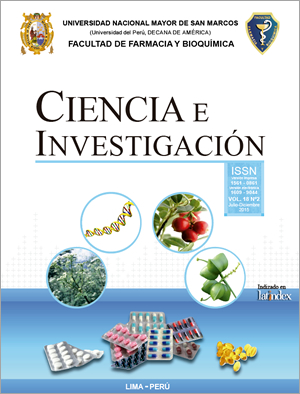Extraction of collagen from wastes processing Engraulis ringens “anchovy”
DOI:
https://doi.org/10.15381/ci.v18i2.13609Keywords:
colágeno, anchoveta, solubilidad proteica, hidroxiprolinaAbstract
The aim of this study was to extract collagen from the waste produced in the processing of anchovies (canned and surimi). To this end, non-collagenous proteins was solubilized with a solution of 0,1N sodium hydroxide and neutralized with successive washes with water (pH close to neutral). Then, the residues were decalcified with a EDTA 0,5M solution; degreased with butanol 10% and finally the collagen protein were solubilized with acetic acid 0,5M and precipitated with sodium chloride 2,6M. Collagen precipitated was dialyzed and lyophilized. The hydroxyproline content (Hip) were quantified in waste and lyophilized collagen, getting the values of 6,5 and 52,9 mg of hydroxyproline/g sample, respectively. The solubility of lyophilized collagen decreased about 40% at a concentration of 12% NaCl. Gel electrophoresis showed a strong band of approximately 110 kDa molecular weight that corresponds to the α1 and α3 chains of collagen type I.Downloads
Published
2015-12-31
Issue
Section
Artículos Originales
License
Copyright (c) 2015 Armando Solari, Javier S. Córdova

This work is licensed under a Creative Commons Attribution-NonCommercial-ShareAlike 4.0 International License.
LOS AUTORES RETIENEN SUS DERECHOS:
- Los autores retienen sus derechos de marca y patente, y tambien sobre cualquier proceso o procedimiento descrito en el artículo.
- Los autores retienen el derecho de compartir, copiar, distribuir, ejecutar y comunicar públicamente el articulo publicado en la Revista Ciencia e Investigación (por ejemplo, colocarlo en un repositorio institucional o publicarlo en un libro), con un reconocimiento de su publicación inicial en la Revista Ciencia e Investigación.
- Los autores retienen el derecho a hacer una posterior publicación de su trabajo, de utilizar el artículo o cualquier parte de aquel (por ejemplo: una compilación de sus trabajos, notas para conferencias, tesis, o para un libro), siempre que indiquen la fuente de publicación (autores del trabajo, revista, volumen, numero y fecha).
How to Cite
1.
Solari A, Córdova JS. Extraction of collagen from wastes processing Engraulis ringens “anchovy”. Ciencia e investigación [Internet]. 2015 Dec. 31 [cited 2025 Jun. 5];18(2):65-8. Available from: https://revistasinvestigacion.unmsm.edu.pe/index.php/farma/article/view/13609






